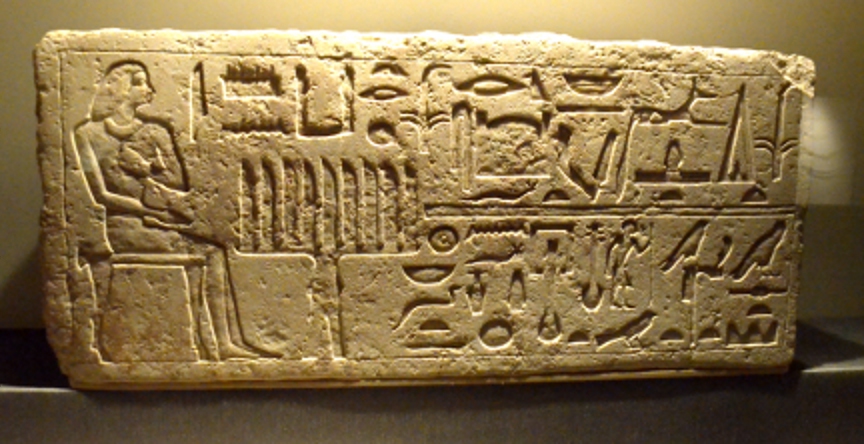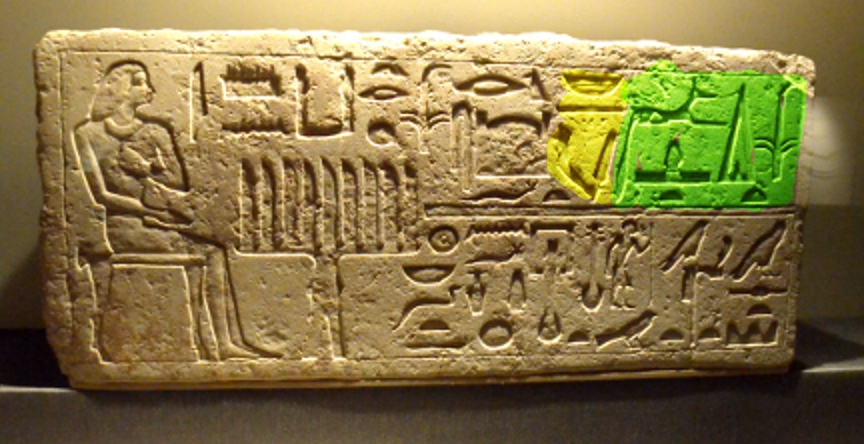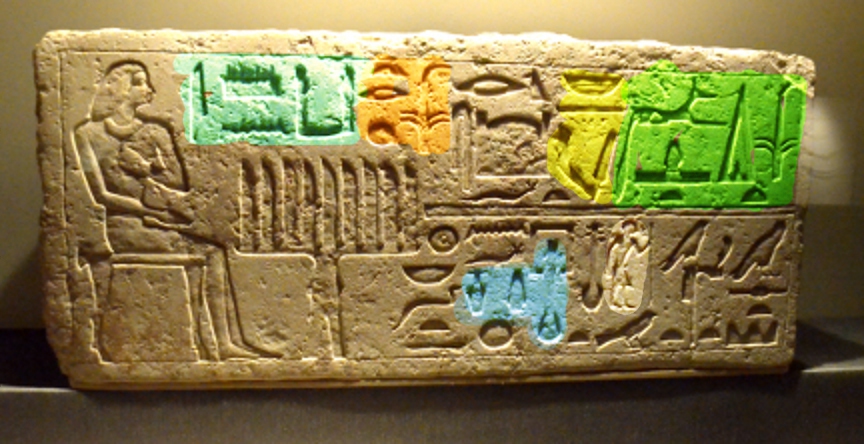It looks like you're using an Ad Blocker.
Please white-list or disable AboveTopSecret.com in your ad-blocking tool.
Thank you.
Some features of ATS will be disabled while you continue to use an ad-blocker.
8
share:
The tale behind his picture is that it's something in the Houston museum. A friend took me there (knowing I love dinosaurs and Egyptian artifacts)
and then had to put up with me scampering all around the displays going "oooh!!! Gorgonopsid!!!! Ooo!!! Anomaolcaris!!! OOOOO!!!" and drooling
all over the cases of Egyptian artifacts (muttering things like "I...think that's ... 'an offering given by the king to Anubis... err... for...
ah... hmmm... that one's... the year, I think... maybe... festival? Oh look! Town of some sort."
That's me. An oversized six year old.
Anyway, he did get some good photos of the hieroglyphs. The plaques were pretty unhelpful (and sometimes just said "stele. 13th dynasty (or whenever.))" which is darn annoying because I can tell there's more there.
Soooo... anyway... I was going to translate this one bit and thought I might put it up here in case anyone else wants to play the translation game.

The text reads right to left (opposite the way we read).
This is a link to a page of online hieroglyph dictionaries
That's me. An oversized six year old.
Anyway, he did get some good photos of the hieroglyphs. The plaques were pretty unhelpful (and sometimes just said "stele. 13th dynasty (or whenever.))" which is darn annoying because I can tell there's more there.
Soooo... anyway... I was going to translate this one bit and thought I might put it up here in case anyone else wants to play the translation game.

The text reads right to left (opposite the way we read).
This is a link to a page of online hieroglyph dictionaries
I think the last 4 on the left are "for the ka of Min en"... not sure if the feather means "the justified" or not. Usually not. If not, then
it's "Min-eni" (a name.)
I could be wrong.
I could be wrong.
Very interesting, but I do not have a clue how to read hyroglyphics. I sometimes wonder if the interpretations are what we think they are. I have
been studying the sounds of the words, like Ka and Ra and La but not the letters themselves. Even these interpretations seem to be tied to what is
being said, it is worse than English. Another thing is that our comprehension now is so much different now than these ancient people had, that
putting things into words does not always work correctly.
I'll let those who know this better translate this stuff. I bet you enjoyed seeing those things. S&F
I'll let those who know this better translate this stuff. I bet you enjoyed seeing those things. S&F
We're sure of the meaning because there are documents with two or more languages... so... Greek and Egyptian, etc. They've been studying hieroglyphs
for over 300 years. Much of the work was done between 1700 and 1900, but some changes have come with the new material. Anyway, the pictures always
relate to the text.
The first set of symbols say "an offering from the king to Anubis.
(that's sedge plant, triangular thing (bread mold, actually), lumpy log, and long tailed canine with collar.) What we do is look these symbols up in "Gardiner's sign list" and then transliterate them. After stumbling around my books, I know that the words are "Hotep di nesuw"... "nesuw" is king, "hotep" is actually 'from' and "di" is offering.
To get this, I use Budge's dictionary (actually, I don't. I use Collier and Manley's book and two others I have on "how to read monuments.)
This is a standard formula, and I can check it by looking at other inscriptions (an offering from the king to Osiris is pretty common.) My books tell me that the next things that follow should be the titles of the god. They never say "to the God Osiris." They'll say "Osiris, lord of the western lands" (etc, etc.) So the next bit is one or more titles of Anubis (maybe. Unless it's Wepauwet). I should be able to figure it out by checking the god titles.
In the bottom right quadrant is the figure of a man with a cane or staff. It *might* be the symbol indicating "old" but it's more likely to be the symbol for "official"... so I expect to see some sort of court title there.
Fastest way to figure it out is to look at some translated items where they have "offering to the god" as part of the inscription.
The first set of symbols say "an offering from the king to Anubis.
(that's sedge plant, triangular thing (bread mold, actually), lumpy log, and long tailed canine with collar.) What we do is look these symbols up in "Gardiner's sign list" and then transliterate them. After stumbling around my books, I know that the words are "Hotep di nesuw"... "nesuw" is king, "hotep" is actually 'from' and "di" is offering.
To get this, I use Budge's dictionary (actually, I don't. I use Collier and Manley's book and two others I have on "how to read monuments.)
This is a standard formula, and I can check it by looking at other inscriptions (an offering from the king to Osiris is pretty common.) My books tell me that the next things that follow should be the titles of the god. They never say "to the God Osiris." They'll say "Osiris, lord of the western lands" (etc, etc.) So the next bit is one or more titles of Anubis (maybe. Unless it's Wepauwet). I should be able to figure it out by checking the god titles.
In the bottom right quadrant is the figure of a man with a cane or staff. It *might* be the symbol indicating "old" but it's more likely to be the symbol for "official"... so I expect to see some sort of court title there.
Fastest way to figure it out is to look at some translated items where they have "offering to the god" as part of the inscription.
edit on
4-9-2013 by Byrd because: (no reason given)
Originally posted by rickymouse
Very interesting, but I do not have a clue how to read hyroglyphics. I sometimes wonder if the interpretations are what we think they are. I have been studying the sounds of the words, like Ka and Ra and La but not the letters themselves. Even these interpretations seem to be tied to what is being said, it is worse than English. Another thing is that our comprehension now is so much different now than these ancient people had, that putting things into words does not always work correctly.
I'll let those who know this better translate this stuff. I bet you enjoyed seeing those things. S&F
It was really interesting watching BBC's 'The Mystery of the Rosetta Stone'.
It is astonishing how they translated it and how much time it took them to figure out and find phonic sounds for Egyptian language.
Also it is sad how many artifacts were taken and got lost, from private collections to being damaged during many wars.
S & F for topic.
reply to post by Byrd
Scratches head.
Doesn't know how he missed this one. Very interesting. Thanks for sharing.
Scratches head.
Doesn't know how he missed this one. Very interesting. Thanks for sharing.
Originally posted by SLAYER69
reply to post by Byrd
Scratches head.
Doesn't know how he missed this one. Very interesting. Thanks for sharing.
There's lots and lots of artifacts in museums around the world, and I'm not sure how many of them are completely translated. If the answer is "not all" then that means there's room for crowd sourcing (including just identifying the individual hieroglyphs so someone can look them up in a dictionary.)
If the answer is "lots" then that means there's a great opportunity to learn hieroglyphs and doublecheck your translations. That's what I'm trying to do now.
Found this on TourEgypt about the hetep-di-nisu:
The hetep-di-nisu, or "a gift which the king gives", is the offering formula or prayer asking for offerings to be given to the deceased. It first appears as the principal inscription on the False Door stelae of the Early Dynastic period, which formed the focus of food offerings in early private tombs, but it continued to be used on funerary stelae ad coffins through to the Graeco-Roman period. From at least the 4th dynasty, the deceased was often depicted sitting or standing before an offering table, beside which was an inscription enumerating all that was offered.
Read more: www.touregypt.net...
edit on 4-9-2013 by Byrd because: (no reason given)
Since some of you seem interested, here's the latest progress.
As I said, knowing that the dog-figure is probably Anubis, the next thing to do is look at titles. This site (down in "chart 33") lists Anubis' titles AND has a link (woohoo!) to the hieroglyphs for the title: www.pyramidtextsonline.com... (I also have the Kamrin book mentioned on this site, so it's a useful combo. I don't think Kamrin's as good as Collier and Manley but it's reasonably good.)
I hit a home run with the first one, "Lord of the Necropolis (sacred land)": twitpic.com...
And now we have this:
In yellow, "a gift given by the king to Anubis"
In green, "lord of the Necropolis"
Next step (later on) will be to go back to the offering formulas and see if I can continue matching. I don't see a symbol that looks like the Egyptian number for a thousand, but I do see on the bottom register near the man symbols that look like the words for bread and beer (as shown in typical offering formulas.) (www.touregypt.net... )
As I said, knowing that the dog-figure is probably Anubis, the next thing to do is look at titles. This site (down in "chart 33") lists Anubis' titles AND has a link (woohoo!) to the hieroglyphs for the title: www.pyramidtextsonline.com... (I also have the Kamrin book mentioned on this site, so it's a useful combo. I don't think Kamrin's as good as Collier and Manley but it's reasonably good.)
I hit a home run with the first one, "Lord of the Necropolis (sacred land)": twitpic.com...
And now we have this:

In yellow, "a gift given by the king to Anubis"
In green, "lord of the Necropolis"
Next step (later on) will be to go back to the offering formulas and see if I can continue matching. I don't see a symbol that looks like the Egyptian number for a thousand, but I do see on the bottom register near the man symbols that look like the words for bread and beer (as shown in typical offering formulas.) (www.touregypt.net... )
Originally posted by Byrd
Im not really to high on translating ancient languages, I leave that up for someone else
But the candle thingy looks very similar to the Menorah, the jewish candle thing
Menorah
I dont know at all, of jewish faith, or its roots. But that is a coincedence for sure.
covertpanther
Im not really to high on translating ancient languages, I leave that up for someone else
But the candle thingy looks very similar to the Menorah, the jewish candle thing
Menorah
I dont know at all, of jewish faith, or its roots. But that is a coincedence for sure.
Actually, that isn't a menorah (menorahs wouldn't be "invented" for another 1500 years after that.)
Those are tables covered in loaves of bread (I know... doesn't look like bread, but if you read the inscription you will see that the person is to be presented with bread). You can see another example from Giza at this link: hearstmuseum.berkeley.edu...
There's a pretty two-colored set here:www.ancient-egypt.co.uk...
edit on 5-9-2013 by Byrd because: (no
reason given)
Byrd,
How's your sheepskin?
Don't get me wrong here - I'm glad to see you posting this. But I'm disappointed.
I thought you were going to show us that the phrase "Two's company, three's a crowd" originated in AE glyphs!
Please keep it up. Seeing the words in the glyphs is something I've always enjoyed.
I first experienced it with the Abydos helicopter, after finding the translations of the Nebty name of Seti I.
Harte
How's your sheepskin?
Don't get me wrong here - I'm glad to see you posting this. But I'm disappointed.
I thought you were going to show us that the phrase "Two's company, three's a crowd" originated in AE glyphs!
Please keep it up. Seeing the words in the glyphs is something I've always enjoyed.
I first experienced it with the Abydos helicopter, after finding the translations of the Nebty name of Seti I.
Harte
Originally posted by Harte
Byrd,
How's your sheepskin?
The dissertation's in the hands of my committee. I'm now getting ready for the Snake Fight. I'm probably going to weep when I see the edits they want.
I thought you were going to show us that the phrase "Two's company, three's a crowd" originated in AE glyphs!
Please keep it up. Seeing the words in the glyphs is something I've always enjoyed.
I first experienced it with the Abydos helicopter, after finding the translations of the Nebty name of Seti I.
Ah. Well, since you asked, several other sections are translated:
The name of the person appears to be "Amun-Ka" (possibly. Will have to doublecheck)
So now, after checking lots of hieroglyphs and texts, we have:

In yellow, "a gift given by the king to Anubis"
In green, "lord of the Necropolis"
In orange "companion of the king"
In aqua is what I THINK is the name. We have "ka" and the symbols for "Amun" which I believe is the name "Amun-ka."
In white-ish is the symbol indicating that there's a court title somewhere in that vicinity.
In blue is "a voice offering" (think of it as a "magical prayer" that someone will write/pray and the items will show up in the afterlife for the person.
Under the green is something that appears to include "of the Western lands" in it.
Originally posted by Byrd
The dissertation's in the hands of my committee. I'm now getting ready for the Snake Fight. I'm probably going to weep when I see the edits they want.
Carry some pepper spray, a wooden mallet and go in with a devilish attitude
new topics
-
The Department of Justice Spies on Congress with Google Assisting.
Political Conspiracies: 3 hours ago -
HOUSE VOTES 320-91 TO BAN CHRISTIAN BELIEFS IN AMERICA
Political Issues: 8 hours ago -
Dugin's interview and the West's complete ignorance of Russia
New World Order: 10 hours ago -
Thousands of Anti-Semitic People Protest Israel's government in Tel Aviv
Middle East Issues: 11 hours ago
top topics
-
Thousands of Anti-Semitic People Protest Israel's government in Tel Aviv
Middle East Issues: 11 hours ago, 9 flags -
Dugin's interview and the West's complete ignorance of Russia
New World Order: 10 hours ago, 9 flags -
HOUSE VOTES 320-91 TO BAN CHRISTIAN BELIEFS IN AMERICA
Political Issues: 8 hours ago, 9 flags -
The Department of Justice Spies on Congress with Google Assisting.
Political Conspiracies: 3 hours ago, 4 flags
active topics
-
Leading Surgeon from Al-Shifa Hospital Dies in Israeli Custody
Middle East Issues • 58 • : cherokeetroy -
Thousands of Anti-Semitic People Protest Israel's government in Tel Aviv
Middle East Issues • 60 • : jofafot -
UN Estimates Rebuilding Gaza Will Cost Up To 40 Billion Dollars
Middle East Issues • 114 • : DBCowboy -
Alien language: If we met extraterrestrials, could we talk to them?
Aliens and UFOs • 71 • : Dreftenq -
Mysterious Spiral 'UFO' Sightings Reported Across US, Europe
Aliens and UFOs • 17 • : Dreftenq -
The Acronym Game .. Pt.3
General Chit Chat • 7796 • : RAY1990 -
The Department of Justice Spies on Congress with Google Assisting.
Political Conspiracies • 10 • : nugget1 -
-@TH3WH17ERABB17- -Q- ---TIME TO SHOW THE WORLD--- -Part- --44--
Dissecting Disinformation • 812 • : daskakik -
Why I believe we are facing Apocalypse. The 'Unveiling' signifiying that the world is at an End.
Conspiracies in Religions • 71 • : AliceTheSmall -
Israeli strikes on southern Gaza city of Rafah kill 22, mostly children, as US advances aid package
Middle East Issues • 149 • : AlongCameaSpider
8
